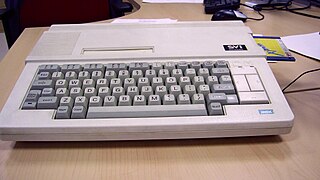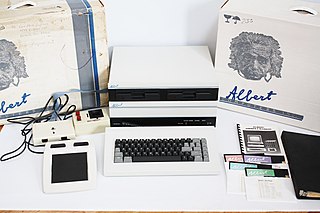
The Dragon 32 and Dragon 64 are home computers that were built in the 1980s. The Dragons are very similar to the TRS-80 Color Computer, and were produced for the European market by Dragon Data, Ltd., initially in Swansea, Wales before moving to Port Talbot, Wales and by Eurohard S.A. in Casar de Cáceres, Spain, and for the US market by Tano Corporation of New Orleans, Louisiana. The model numbers reflect the primary difference between the two machines, which have 32 and 64 kilobytes of RAM, respectively.

The RadioShack TRS-80 Color Computer, later marketed as the Tandy Color Computer, is a series of home computers developed and sold by Tandy Corporation. Despite sharing a name with the earlier TRS-80, the Color Computer is a completely different system and a radical departure in design based on the Motorola 6809E processor rather than the Zilog Z80 of earlier models.

The Atari 8-bit computers, formally launched as the Atari Home Computer System, are a series of home computers introduced by Atari, Inc., in 1979 with the Atari 400 and Atari 800. The architecture is designed around the 8-bit MOS Technology 6502 CPU and three custom coprocessors which provide support for sprites, smooth multidirectional scrolling, four channels of audio, and other features. The graphics and sound are more advanced than most of its contemporaries, and video games are a key part of the software library. The 1980 first-person space combat simulator Star Raiders is considered the platform's killer app.
MSX BASIC is a dialect of the BASIC programming language. It is an extended version of Microsoft's MBASIC Version 4.5, adding support for graphic, music, and various peripherals attached to MSX microcomputers. Generally, MSX BASIC is designed to follow GW-BASIC, released the same year for IBM PCs and clones. During the creation of MSX BASIC, effort was made to make the system flexible and expandable.

The TMS9918 is a video display controller (VDC) manufactured by Texas Instruments, in manuals referenced as "Video Display Processor" (VDP) and introduced in 1979. The TMS9918 and its variants were used in the ColecoVision, CreatiVision, Memotech MTX, MSX, NABU Personal Computer, SG-1000/SC-3000, Spectravideo SV-318, SV-328, Sord M5, Tatung Einstein, TI-99/4, Casio PV-2000, Coleco Adam, Hanimex Pencil II, PECOS and Tomy Tutor.

The ThomsonMO5 is a home computer introduced in France in June 1984 to compete against systems such as the ZX Spectrum and Commodore 64. It had a release price of 2390 FF.
Dragon Data Ltd. was a Welsh producer of home computers during the early 1980s. These computers, the Dragon 32 and Dragon 64, strongly resembled the Tandy TRS-80 Color Computer ("CoCo")—both followed a standard Motorola datasheet configuration for the three key components. The machines came in both 32 KB and (later) 64 KB versions.

The Yamaha V9958 is a Video Display Processor used in the MSX2+ and MSX turbo R series of home computers, as the successor to the Yamaha V9938 used in the MSX2. The main new features are three graphical YJK modes with up to 19268 colors and horizontal scrolling registers. The V9958 was not as widely adopted as the V9938.

The Yamaha V9938 is a video display processor (VDP) used on the MSX2 home computer, as well as on the Geneve 9640 enhanced TI-99/4A clone and the Tatung Einstein 256. It was also used in a few MSX1 computers, in a configuration with 16kB VRAM.

The SV-328 is an 8-bit home computer introduced by Spectravideo in June 1983. It was the business-targeted model of the Spectravideo range, sporting a compact full-travel keyboard with numeric keypad. It had 80 KB RAM, a respectable amount for its time. Other than the keyboard and RAM, this machine was identical to its little brother, the SV-318.

The FM-7 is a home computer created by Fujitsu. It was first released in 1982 and was sold in Japan and Spain. It is a stripped-down version of Fujitsu's earlier FM-8 computer, and during development it was referred to as the "FM-8 Jr.".

The Spectravideo SVI-738 X'Press is an MSX1 compatible home computer manufactured by Spectravideo from 1985. Although compatible with the MSX 1.0 standard, it incorporates several extensions to the standard ; many are hardware-compatible with the MSX 2.0 standard but the system as a whole is not, leading to it being referred to as an "MSX 1.5" computer.

The Panasonic FS-A1WSX released in 1989 was the last MSX2+ made by Panasonic. It was the successor of FS-A1WX and incorporated few changes like S-Video output, no tape support, color printer support and an improved A1 Internal Cockpit software with a Kanji color word processor.

Corvette was an 8-bit personal computer in the USSR, created specifically for Education in the Soviet Union in the 1980s. The initial prototype of this computer emerged in 1985 as a project by Moscow State University employees, primarily for conducting physics experiments. It was originally a homemade computer. The first description, including the documentation detailing its specifications, was made in the magazine «Microprocessor tools and systems». The PC was named PK 8001.

The Albert is an Apple II clone, released by Albert Computers, Inc., in 1983. Comparable to the Apple IIe, six models were ultimately produced.
The Philips NMS 8220 is a personal computer released in 1986 and compatible with the MSX2 standard. Developed by the Dutch electronics company Philips, it was aimed at both home users and small businesses. The NMS 8220 was one of the many computers that adhered to the MSX standard, a popular home computing platform in the 1980s that sought to unify hardware specifications across various manufacturers, enabling software compatibility.

The Philips NMS 8280 was a MSX2 computer from the Dutch company Philips, launched in 1987. The abbreviation NMS stands for New Media System. Its integrated genlock enabled professional video use, and the case allowed installation in a video rack. Intended be a video editing system, the machine was sold with a mouse. The hardware was developed by Sanyo and is based on the Sanyo MPC-27.
The Philips VG-8230 is a MSX2 standard compatible personal computer released in 1986. It was the first MSX2 machine from Philips, aimed at home users with a focus on both gaming and productivity.

The Philips VG-8235 is a Philips MSX2 compatible home computer, released in 1986 in Europe. It was developed and manufactured by the NEC.
















